Prof Richard Hague’s desk is littered with a curious smorgasbord of objects: a tiny model jet engine, a diesel-fuel pump housing, a chain-mail vest with a zip down the back, a football shin pad and a tiny skeletal hand. A seemingly random array of objects, but with one important thing in common: they’ve all been built by machines that can be used to print functional components from scratch.
Hague, who heads up Loughborough University’s world-leading Additive Manufacturing Research Group (AMRG), explained that these so-called ’additive’ machines, which use a range of laser-based or advanced printing techniques to build up models layer by layer, have a number of compelling advantages over traditional manufacturing techniques.
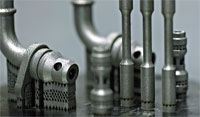
Able to build models of mind-boggling geometrical complexity from scratch, they dispense with tooling costs. Plus, there’s very little waste. While traditional ’subtractive’ manufacturing processes often remove up to 95 per cent of the raw material to arrive at a finished component, additive machines only use the material they need to make the part.
“This technology is almost as close to Nirvana as you’re ever going to get.”Prof Richard Hague, AMRG
But most compelling of all, Hague explained, is the almost limitless freedom the technology gives to designers. ’It frees you from the constraints of traditional manufacturing processes. It changes the kind of products you can make and the way you design things. You can make very, very complicated geometries. It’s almost as close to Nirvana as you’re ever going to get.’ Critically, this unprecedented design freedom enables the production of lightweight optimised components that are impossible to make with traditional techniques. Hague is effusive on the possibilities and potential of the technology, and in particular the UK’s expertise in the field. ’We talk a lot about new industry and new jobs, high-value manufacturing and advanced manufacturing - it fits any of those definitions,’ he said.
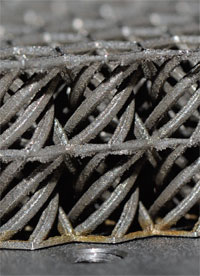
Gratifyingly, he’s not a lone evangelist for the technology. Indeed, the UK boasts a number of groups that can rightly describe themselves as world leading. Another leader in the field is Dan Johns, who heads up the Centre for Additive Layer Manufacturing (CALM) at EADS Innovation Works near Bristol. ’Even without changing the component at all, additive-layer manufacturing (ALM) means that you’re extracting 26 times less material out of the ground to make it,’ said Johns. And this isn’t just a matter of material saving. John Piper, engineering consultant on the Bloodhound Supersonic Car project, which has been working with Johns’ team, outlined some of the other benefits. ’Machining starts with a block of aluminium or titanium,’ he said. ’There’s a huge investment in the process to make that billet: heat-treating it, rolling it, reheating it, cutting it up and bringing it to the machine. Add the issue of making the tooling and you’re looking at very significant process input, even before you start machining. And with conventional machining, most of that expensively produced material gets chucked into the swarf bucket.’
ALM gives the aviation industry a solution to a longstanding problem
At EADS, Johns held up a chunky metal component, looking like a squared-off gardening trowel with a curved handle. ’This is a section of the landing gear from an A380, made by conventional machining,’ he said. ’With this as our starting point, we used computerised stress analysis and topology optimisation to reveal where the loads and stresses in this component are, and used that data to design a component that consists only of the sections that carry the load.’
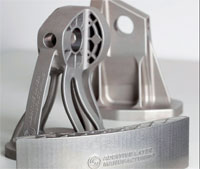
He then held up a component built up from graceful, organic-looking metal curves, flowing around the points where the part would connect to the rest of the landing-gear structure. It resembled a scaled-up bird’s skull. ’This is what you then make with ALM,’ he said. ’The structure is complex but, as we’re building it layer by layer, that makes no difference at all. It weighs less than half the original component and we’ve removed all the redundant weight, but it would perform exactly the same function.’
The process starts with a CAD file, modelling the component in three dimensions. Once the solid model is in place, engineers have to make manufacturing decisions - the most important of which is the orientation of the layers from which the component will be built. This is still very much a matter of judgement and there are no automated or computerised shortcuts - Johns’ team describes it as the ’black art of ALM’. But once this has been decided, the ALM machines themselves take over, slicing the model into layers whose thickness depends on the type of machine and the material being used.
Additive Layer Manufacturing: how it works
Additive manufacturing is often referred to as 3D printing, as it works in a similar way to a laser printer. The technique builds a solid object from a series of layers - each one printed directly on top of the previous one.
The raw material for ALM is a powder, which can be a thermopolymer or a metal; aluminium, stainless steel and titanium 6,4 are common. The printing chamber is generally heated to 10ºC below the melting point of the material - this ensures that the laser used to heat the powder can melt it quickly. For metals, this preheating eliminates residual stress from their processing, which can make them warp when welded.
The machines’ operating software cuts the CAD model of the workpiece into slices, whose thickness depends on the type of material used; CALM uses 0.1mm for polymers and 30 microns for metals. A blade mounted on a moving arm sweeps an even layer of the powder on top of the work surface inside the chamber, then a laser - generally around 200W - scans back and forth over the surface, melting the powder in the shape of the first layer. The work surface then drops by the thickness of the layer and another layer of powder is distributed over the surface.
Other ALM machines use electron beams rather than lasers, as they are capable of transmitting more energy and therefore melt the powder faster. These machines work at room temperature, again speeding up the process. However, they produce pieces with a rougher surface finish that requires further machining and residual stress isn’t eliminated.
Interestingly, it’s one of the UK’s other great areas of niche engineering expertise that is helping to drive the additive industry forwards. Many members of the CALM team come from motorsport and Johns believes that the UK’s dominance in this sector is a positive help in carving out ALM expertise.
“We have technology that can make more complex things than we can design.”Prof Richard Hague, AMRG
’It was Formula 1 that got me into ALM,’ he explained. ’We’d been using CAD to make solid models using rapid prototyping, which we’d then test in the wind tunnel.’ The system used most often was stereolithography, which uses a liquid resin solidified in layers by a UV laser. ’We wanted to go beyond that to see what we could do with metal-based systems and other polymers, and see where that could fit in to the production cycle.’ Scaling up the process from models to full-sized components was an obvious step, which led Johns to EADS.
It’s a route that he sees as extremely important and a real strength for the UK. ’The motorsport sector acts as a bridge between aerospace and the automotive supply chain,’ he said. ’It’s become a forum where people who are used to working with the high-tech processes and materials used in fighter aircraft, for example, mix with the people whose background is in the mass-production area and they focus on concrete problems with short deadlines. It’s an important way of getting techniques such as ALM into the mainstream in a practical way.’
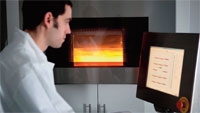
Back at Loughborough, Hague’s group is actively addressing many of the challenges that could help push the technology further into the manufacturing mainstream. One of the most ambitious of these is the £3m TSB-funded Atkins project, which is looking at how the aerospace and automotive industry could benefit from the technology.
Heading up a consortium that includes Boeing, Virgin Atlantic, Bentley, Delphi and UK machine-tool firm MTT, Hague’s team is looking at how additive techniques could help reduce waste, weight and emissions during both the production of a component and its use. ’If you make it lighter weight at the production stage you use fewer materials and if you make it lighter weight during the use stage you use less fuel - it’s a double hit,’ explained Hague.
Indeed, the aerospace industry, despite its large pockets of conservatism, has a relatively long history of embracing additive processes. Boeing put laser-sintered cooling ducting on the F18 around 10 years ago and the 787 Dreamliner also features a number of non-critical laser-sintered components. Meanwhile, Airbus is trialling components made by Johns’ team, including control surfaces, cooling systems and the reduced-weight landing gear and bracket components.
According to Dr Phil Reeves, managing director of UK additive manufacturing consultant Econolyst, the technology also presents the aviation industry with an intriguing solution to a long-standing problem. ’As soon as an aircraft takes off, does its maiden flight and lands, the CAD data is no good anymore as the aircraft has changed shape,’ he said. According to Reeves, additive techniques could enable aircraft companies to produce replacement parts and spares that are optimised to take account of these changes.
“We’ve earmarked the prospect of growing a full-sized airliner wing.”Dan Johns, EADS
But by far the biggest adopter of additive technology is the medical devices sector and, around the world, many patients sport hip replacements, dental crowns or even cranial implants that have been produced by clinicians on laser-sintering machines. Indeed, the largest-volume application of additive manufacturing is in the production of hearing aids, with customised hearing-aid casings now almost exclusively made using additive techniques.
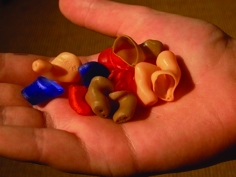
Interestingly though, Reeves claimed that the biggest spur for adoption of the technology in the medical world is not customisation, but economics. ’Most of the interest in using metal-based additives for implants is currently for affordable healthcare,’ he said. ’For instance, the traditional manufacturing process for an acetabular cup [the socket of the hip joint] is a drop forging that is CNC machined and then has a coating put on it for the bone to grow in to the coating. With additive, because we’re building in particles, we can change the density and make the surface of the implant porous so you don’t have to go through a secondary downstream ceramic operation. It’s a lot cheaper.’
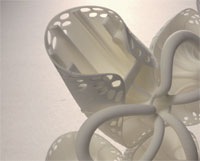
And it’s not just the existing engineering sectors that are driving innovation in the field. Intriguingly, many additive machines - themselves low-volume products - are built from parts made on additive machines. ’The guys who make these machines use the machine to make the machine,’ said Reeves. ’There are 24 component parts in an EOS machine made on an EOS machine’
Reeves is also particularly excited by the appearance of a number of online consumer businesses that use additive techniques to produce their products. For instance, visitors to the website of Singapore firm Jujups are able to design their own personalised mugs, which are then produced on additive machines, while Dutch consumer-products company Freedom of Creation is now the world’s largest producer of laser-sintered products.
But, while this model is helping the additive industry to lay down some roots, it’s the potential to create functional components for demanding applications that is most exciting for engineers.
So could additive components ever be used for highly stressed load-bearing applications?
In theory, said Reeves, the components produced are already strong enough to be relied on in the most testing scenarios. ’On paper, metallic additive parts have mechanical properties that are better than cast and getting towards wrought, but there is currently no agreed standard for material and process quality. Once we start to see some recognised standards for testing then we’ll see people starting to put some faith behind the technology and putting it into applications,’ he said.
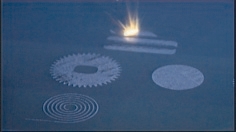
One highly demanding engineering project, the land-speed record attempt Bloodhound SSC, is already looking at ALM to make highly loaded components (see box below). But for larger production projects, the issue of qualification is vital. EADS is among the companies facing the challenge and is working towards standardisation through projects that will see ALM components going into space.
ALM engineer Chris Turner is working on components for an Astrium communications satellite set for launch this year, in particular a hold-and-release mechanism to keep the delicate solar panels folded alongside the satellite during launch. ’This replaces a six-part assembly with a single piece, which reduces the part count and takes out a massive amount of assembly,’ he said.Because every satellite is custom-built, the small-volume capability of ALM makes it ideal for designing components. Moreover, if they survive the high g-forces and vibration of a rocket launch, it will give customers in other industries confidence that the technique is suitable for them.
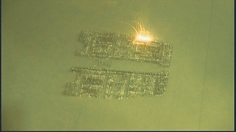
’It’s all part of the qualification process; the users have to be sure that the component will perform,’ Johns said. ’And that goes all through the process; we have to qualify things such as particle size, laser power and duration of pulses - every aspect. But once we’ve done that, we can start scaling up our thinking.’
But it’s not all about regulation and, despite the high quality of today’s additive parts, there are still huge improvements to be made to the technology.
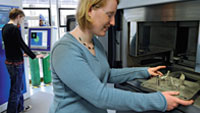
A major issue is the sensitivity of current machines, which require careful optimisation to produce the desired mechanical properties.
’These are fairly delicate machines at the moment,’ Hague said. ’To get a perfectly optimised component, you really have to characterise the machine.
’Maintaining temperature is very difficult and you tend to get different properties on laser-sintering machines on different days, on different builds and in different locations - there’s a research challenge there in looking at how you can control the mechanical properties.’
Another issue has to do with raising awareness of the technology’s capabilities. ’We’re still in the early days of using these systems for production,’ said Reeves. ’Many users of additive machines are still using them for prototyping rather than production.’ Hague agreed that educating companies about the opportunities created by additive technology is a stiff challenge. ’If you’re a designer in company making a component, to design it in a different way using a different material and a different process is quite a big ask.’ The technology, he said, needs vocal champions.
Another technical issue holding back the wider deployment of additive techniques is the range of limitations of existing design software.
’Conventional CAD systems and design tools aren’t really up to the job of dealing with this kind of complexity,’ said Hague. ’We have manufacturing technologies that can make more complex things than we can actually design. A large effort of our research group is coming up with new software techniques.’ At EADS, Johns is experiencing the same problem and looking at imaging software used in the creative industries, such as computer gaming, and in medical visualisation systems for inspiration.
https://www.youtube.com/watch?v=pppY8qvC73I
Reeves envisages some even more fundamental advances over the next decade. ’At the moment we tend to manufacture parts in a single material,’ he said. ’But we’ll start to see functionality embedded into parts: electric tracks, optical tracks, different materials with different strain characteristics and maybe even sensors printed into parts as they are built.’ Displacing multiple manufacturing operations in this way will, he believes, make additive processes even more cost-effective.
Research around this is currently focused on polymer components, Johns explained. ’Today’s polymers used in ALM are low modulus; you wouldn’t want to put them on an aircraft,’ he said. ’A lot of our research development is into high-performing polymers such as PEEK and that gives us the opportunity to introduce things such as carbon-nanotube technology.’
The EADS team has already succeeded in growing aligned nanotubes within ALM structures, Johns said. ’We have a lot of IP developing around a material we’ve called Utopium,’ he said. ’This is future-fantastical stuff, but we could bring the values of carbon nanotubes into a material system, controlling the material structure and functionality. That would allow us to think about embedded sensor technologies. You could even use them for wing morphing.’

Reeves said the next generation of machines will exploit advances in technology to become much faster. ’We’ll have moved away from the traditional approach of taking a single spot of energy and rastering it back and forwards. We’ll expose whole layers and flash them.’
Given this vision of a new generation of large, faster additive machines constructing advanced functional components trusted by the most risk-averse industries, it seems reasonable to ask whether this new vanguard of manufacturing technology could replace the traditional processes?
’I don’t think we’ll see the demise of moulding or machining,’ said Reeves, ’but we’ll definitely see dedicated manufacturing facilities using just this and we will also see these technologies starting to appear on traditional shopfloors.’
Indeed, Johns’ plans see ALM taking a major place in aircraft manufacture. ’We do, quite genuinely, have large-scale structures grown from ALM-enabled manufacturing systems on our technology route maps,’ he said. ’And that does mean the prospect of growing a full-sized airliner wing, which we have earmarked for some time beyond 2020.’ This isn’t a far-fetched notion, Johns insisted. ’Go to [Airbus wing-making facility] Broughton in North Wales and you’ll see 35m-long gantry machining centres with CNC heads for bespoke machining of whole wing skins. Change the machining head to a laser-deposition head and you can start to see the possibilities straight away.’
But perhaps the biggest change that ALM might engender is in the way that engineers work and, in fact, it’s a change back in time. CALM’s ALM engineer Chris Turner said the technique restores the link between designer and manufacturer that dates back to the days of the industrial revolution and the very first factories. ’We get instant feedback; we can make changes, redesign and rebuild. It’s making me think in a different way about engineering and manufacturing; it’s very liberating.’
what’s next
Desktop Factory
Additive machines break into the consumer market
When Hewlett-Packard launched an ’affordable’ desktop 3D printer earlier this year, critics scoffed at its £11,200 price tag. This was not the people’s printer that some had been hoping for.
But, as the technology becomes more widespread, the cost will inevitably drop and many believe that it won’t be long before the consumer market for additive machines really takes off.
’We’ll see the low-end entry machines coming down and down in price to a point where they are consumer goods,’ said additive-industry consultant Dr Phil Reeves. ’Within 10 years I can’t see any reason why we won’t have a sub-£500 machine.
’There are literally millions and millions of hobbyists in the world - whether they’re making remote-control cars, realistic facsimiles of warships or robots for robot wars, it will only take one big electronics company to see some value in this.’
’We’ll see a real divergence between production machines and these low-cost fabrication technologies,’ said Reeves. ’I can’t see why anyone who’s not serious about industrial design won’t have a machine in a few years. It will be as common as having a laser printer in your office.’
Additive manufacturing breaks the sound barrier
ALM components help rocket-powered vehicle break land-speed record
Power on the ground
When Wing Commander Andy Green attempts to pilot the Bloodhound SSC above 1,000mph next year, he will be surrounded by ALM components. John Piper, engineering director for the first stage of the project, said that it wasn’t so much a question of which components would be made using the technique: ’Once we’d seen what it could do, it was more of a question of what wouldn’t we want to make with it?’
With the risks inherent in taking land speed to unpreced-ented levels, it might seem odd to use an untried production technique for vital components but, for Piper, the decision wasn’t difficult. ’We’re only building one car and it’s unlikely we’ll build any spares,’ he said. ’We’re not going to run the car so much that anything will wear out - the only failure mode is an accident or problems with assemblage. In those cases, it’s unlikely we’d want another part exactly the same - we’ve got to redesign it and make another one.’
“What wouldn’t we want to make with it?”John Piper, Bloodhound SSC
This means that the team needs a technique that allows them to make one-off, geometrically complex, highly optimised components in high-quality materials that are capable of carrying large stresses. ’If we want to change or develop it, or it’s not what we want, ALM means that we haven’t invested a lot of tooling, and process and machining time, and we can have a new one overnight,’ Piper said.
The team is still in the design phase of the project, but several components have already been picked out for ALM. ’The foot controls, which control the dry heat, reheat and throttle, are a sophisticated set of components,’ Piper said. ’It’s adapted from the throttle body in a combat aircraft and we have to translate that from a hand control to a foot control. It’s very convenient to make that with ALM.’
Bloodhound’s steering wheel is another ALM target - a one-off component tailored precisely to Green’s grip. ’It’s a W-shape with lots of buttons and triggers. It would be very difficult to machine the mountings for all those controls and it’s such a complex shape, so ALM is perfect.’
ALM’s potential for designing to handle stress could also be used - the chassis frame will include several brackets where stress is redistributed into the monocoque chassis section.




Red Bull makes hydrogen fuel cell play with AVL
Formula 1 is an anachronistic anomaly where its only cutting edge is in engine development. The rules prohibit any real innovation and there would be...